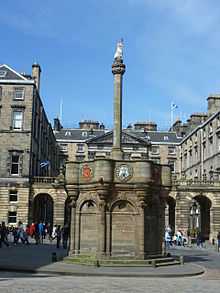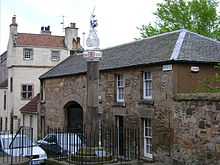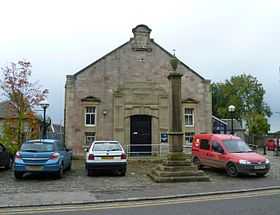Mercat cross



A mercat cross is the Scots name for the market cross found frequently in Scottish towns, cities and villages where historically the right to hold a regular market or fair was granted by the monarch, a bishop or a baron. It therefore served a secular purpose as a symbol of authority, and was an indication of a burgh's relative prosperity. Historically, the term dates from the period before 1707 when Scotland was an independent kingdom, but it has been applied loosely to later structures built in the traditional architectural style of crosses or structures fulfilling the function of marking a settlement's focal point. Historical documents often refer simply to "the cross" of whichever town or village is mentioned. Today, there are around 126 known examples of extant crosses in Scotland,[1] though the number rises if later imitations are added.
History
The earliest documentary reference occurs in the reign of William the Lion (1165-1214), when it was decreed that "all merchandises sal be presentit at the mercat and mercat croce of burghis".[2] Early town crosses may have continued the tradition of church crosses used to mark consecrated land or sanctuary boundaries, and functioned similarly to early ecclesiastical crosses, from before the building of stone churches, in marking a communal gathering place. They are thought to have been originally pillars of wood, possibly placed on stone bases, changing to stone pillars in later centuries.[3] Some, as at Inverkeithing, incorporate sundials (the pillar of each cross itself acts as a primitive sundial).
The cross was the place around which market stalls would be arranged, and where 'merchants' (Scots for shopkeepers as well as wholesale traders) would gather to discuss business. It was also the spot where state and civic proclamations would be publicly read by the "bellman" (town crier). For example, in 1682 a town guild in Stirling was accorded the privilege of making a proclamation, to be "intimat at the Mercat Croce that no person pretend ignorance."[4] To this day, royal proclamations are still ceremonially read in public at the Mercat Cross in Edinburgh, including the calling of a general election and succession of a new monarch.
The cross was also the communal focal point of public events such as civic ceremonials, official rejoicings, and public shamings and punishments, including executions. Some crosses still incorporate the iron staples to which jougs and branks were once attached. Communal gatherings still take place at crosses, as at Galashiels on "Braw Lads Day" or Peebles at the start of the Beltane Festival. Crosses are often the place to mark the start or end of Common Ridings as at Musselburgh or events such as the Stonehaven fireball ceremony.
Descriptions
Despite the name, the typical mercat cross is not usually cruciform, or at least has not been since the iconoclasm of the Scottish Reformation. The cross atop the shaft may have been replaced with a small statue, such as a royal unicorn or lion, symbols of the Scottish monarchy, or a carved stone displaying the arms of the royal burgh, or, in the cases of ecclesiastical burghs or burghs of barony, the bishop's or feudal superior's coat-of-arms. These are often painted. Another finial commonly seen is a stone ball as at Clackmannan and Newton Stewart. The shaft is usually surmounted by a plain or decorated capital. A variety of decorative designs are employed, including foliage, emblems like thistles and roses, armorial shields, and mouldings of the egg-and-dart type.
Five crosses: at Edinburgh, Dundee, Perth, Aberdeen and Preston (modern Prestonpans) were supported by a drum-shaped understructure, known as a cross-house, with a platform reached by internal steps or ladder. In the case of Aberdeen's late 17th-century cross the platform is supported by a series of open semi-circular arcades. The Preston Cross, built in the early 17th century,[5] is the only one of the type still existing on its original site. This traditional design has been replicated approximately with added Scots baronial elements in Victorian reconstructions at Edinburgh and Perth. A plainer understructure faintly echoing the design was adopted for Glasgow's cross when a replacement was erected on or near the site of the original in 1921; and simpler versions exist elsewhere, as at Elgin and Selkirk. Most crosses, however, stand on stepped, often octagonal stone bases and are of an average height of between 9 and 13 feet.[6] In some cases, as at Musselburgh (see gallery image) and Kirkcudbright, the pillar is secured within or stands upon a solid stone structure.
Some mercat crosses of today are replicas from the Victorian period, as at Dunfermline and Scone, though they often incorporate one or more original elements, particularly the shaft or a section thereof. Some crosses, as at Linlithgow and St. Andrews, were replaced with public drinking fountains substituting for older, demolished crosses, and some were adapted as war memorials after the Great War of 1914-18. A war memorial may incorporate a part of the original cross, as at Renfrew or Bowden, or have been built deliberately in the style of a mercat cross, as at Lauder and Moffat. The war memorials at Abernethy, North Berwick and Portree also closely resemble mercat crosses and are known as such. The last, of course, lies geographically well outside the historic area of Scottish Lowland burghs.[7] Another example of what might be termed an imitation cross is the war memorial at Dalmeny. It provides the village with a customary focal point and gives the impression that it is much older than its 19th-century origin, but is not indicative of a historical market.
Taken for granted as a normal part of the street scene, crosses have in the main been poorly documented in the past regarding their dates of erection, relocation and remodelling, and they often suffer from neglect in the present. Many no longer stand in their original position. Some, such as Forfar's,[8] and Queensferry's have disappeared, and some, such as Cupar's and Banff's, have been moved to a location outside the burgh but later retrieved and re-erected.[9]
Scottish emigrants to countries such as Canada and especially Australia took the idea of the mercat cross with them, and several cities in the New World have or once had them in the town centre.
List of places with mercat crosses
Gallery
-
one of the oldest surviving crosses still on its original site at Prestonpans, East Lothian
-

one of the finest examples of a mercat cross at Inverkeithing in Fife
-

the cross at Coldingham in Berwickshire
-
the cross at Cockburnspath in Berwickshire
-

the cross at Pencaitland, East Lothian
-

the cross at Gifford, East Lothian
-

the cross at Carnwath, Lanarkshire, with inscribed mile distances to other burghs
-

the Canongate Cross in Edinburgh, topped by a cross symbolising the former ecclesiastical burgh
-
the cross at Stirling, topped by a unicorn
-
the cross at Doune, near Stirling, topped by a lion
-
the cross at Cupar in Fife
-
the cross at Peebles in the Scottish Borders
-
the cross at Musselburgh, East Lothian, topped by the burgh arms
-

the cross at Haddington, East Lothian, topped by the town's symbol, a goat
-
the cross at Dundee, re-erected at a new location in 1874 without its original octagonal cross-house
-
the cross at Dunfermline, Fife
-
the cross at Crail, Fife
-
the cross at Anstruther, Fife, missing its finial
-
the cross in the village of Kinrossie, Perthshire
-
the cross in the 'new' village of Scone, topped by a foliated ornamental cross
-
the cross in the town of Clackmannan
-
the cross in the village of Airth near Falkirk, incorporating sundials
-
some towns, like Hawick in the Scottish Borders, lost their crosses because they were increasingly deemed obstructions to wheeled traffic
-
The Cross Well at Linlithgow, modelled on the courtyard fountain of Royal palace, substitutes for the town's demolished cross
-

the cross at Sanquhar was transformed into a Covenanter monument in 1856
-
the cross at Abernethy. An example of a war memorial in the form of a mercat cross.
-
Edward VII Memorial in Perth (1913), replacing the town's original cross removed in 1763
See also
References
- ↑ Scottish Market Crosses: The development of a risk assessment model
- ↑ W G Black, The Scots Mercat Cross, Edinburgh 1930, p.27
- ↑ A Hutcheson, Introduction to J Small, Scottish Market Crosses, Stirling, 1900
- ↑ J Small, Scottish Market Crosses, Stirling, 1900, p.iv
- ↑ RCAHMS Site Record for Preston Cross on Canmore
- ↑ J Drummond, Scottish Market Crosses, Edinburgh 1861
- ↑ P McNeill and R Nicholson (eds.), An Historical Atlas Of Scotland c.400-c.1600, Atlas Committee of the Conference of Scottish Medievalists, University of St. Andrews, 1975, pp.31-2
- ↑ Castle Hill, Antiquities, and Points of Interests around Forfar, Scotland
- ↑ RCAHMS Site Record for Cupar Market Cross on Canmore
External links
| Wikimedia Commons has media related to Mercat Cross, Edinburgh. |
- Mercat Cross
- Rampant Scotland
- Glasgow Mercat Cross
- Scottish Market Crosses: The development of a risk assessment model by Dr. Lindsey J Thomson
| ||||||||||||||||




















